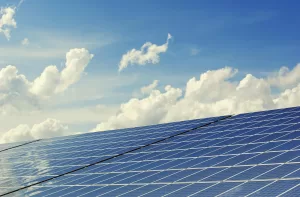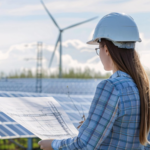In high-latitude regions like Northern Europe and Canada, winter brings short daylight hours and a low solar altitude, significantly reducing photovoltaic (PV) system output. However, as spring arrives, daylight hours increase, and the sun’s angle rises, creating a new peak period for solar generation. Maximizing the benefits of this seasonal shift is crucial for optimizing PV system performance in high-latitude areas.
This article delves into the challenges of springtime solar applications in high-latitude regions and presents innovative solutions, such as the application of reflective materials, intelligent tracking system optimizations, and advanced module designs, to help solar professionals enhance project efficiency and profitability.
Challenges of Springtime Solar Power in High Latitudes
Despite the increase in daylight hours during spring, high-latitude solar systems still face key challenges:
- Low Solar Altitude:Even with the return of sunlight, the sun remains relatively low in the sky, limiting the amount of solar radiation that PV panels can receive compared to lower-latitude regions.
- Large Temperature Variations:Early spring temperatures can be quite low, which may impact module and inverter performance but can also enhance PV module efficiency due to the temperature coefficient effect.
- Day-Night Temperature Fluctuations and Ice/Snow Effects:Sudden drops in nighttime temperatures can lead to frost formation on module surfaces, reducing light transmittance and impacting overall performance.

How to Optimize Solar Power Generation in Spring for High-Latitude Regions?
To overcome the challenges and increase solar power generation during the spring, the following optimization measures can be implemented:
1. Application of Reflective Materials: Enhancing Incident Light Utilization
Data Support: Studies show that the use of appropriate ground reflective materials can increase the total irradiation of a PV system by 10% to 30% (Source: National Renewable Energy Laboratory, NREL – www.nrel.gov).
- White Reflective Films:Installing high-reflectivity materials (e.g., white reflective films or coatings) underneath the PV array can increase back-side illumination, particularly effective for bifacial modules.
- Optimized Installation Angle:Adjusting the angle of the PV modules to capture more reflected light from the ground maximizes light utilization.
- Snow Reflection: Snow in high-latitude regions is a natural high-reflection material that enhances irradiation reception, but mounting height needs to be optimized to reduce the impact of snow coverage.

Real Case: A photovoltaic farm in Jiangsu Province, China, used high-reflectivity white film beneath the modules, resulting in a 10% increase in electricity generation.
(Case Source: ENSI)
2. Smart Tracking Systems: Dynamically Adjusting Module Angles
Data Support: A single-axis tracking system can improve annual energy generation by 15% to 25% in high-latitude regions, while a dual-axis tracking system can boost generation by over 30% (Source: Fraunhofer ISE, Germany – www.ise.fraunhofer.de).
- Single-Axis Tracking System:Ideal for areas with significant seasonal variation in sunlight, adjusting the tilt angle so that the modules always face the sun, maximizing light utilization.
- Dual-Axis Tracking System:More precise, capable of adjusting to spring’s variable sun angles, thereby optimizing energy production.
- AI Optimization:Combining weather forecasts and light intensity data, AI can intelligently adjust module angles for enhanced energy yield.
Case: A photovoltaic power station in China adopted a single-axis tracking system, boosting spring power generation by 18% compared to fixed mounts.
Case Source

3. New Module Designs: Enhancing Weak Light and Scattered Light Utilization
With low sun angles and higher scattered light in the spring, the ability of modules to respond to weak light is crucial.
- TOPCon and HJT Modules:Compared to traditional PERC modules, TOPCon (Tunnel Oxide Passivated Contact) and HJT (Heterojunction) modules exhibit better weak light response, making them ideal for high-latitude regions.
- Bifacial Modules+ High-Reflection Grounds: Bifacial modules can utilize additional ground-reflected light, and combining them with white reflective films can increase generation by 10-15%.
- Nano Anti-Reflection Coatings: Reducing light loss on the module surface increases photon absorption and improves scattered light utilization efficiency.

Investment Return Analysis for Spring Solar Power in High-Latitude Regions
In summary, the following solutions can effectively improve solar power returns in high-latitude regions during the spring:
Optimization Solution | Power Generation Gain | Applicable Scenarios |
Reflective Materials (White Film, Coatings) | 10%~15% | Bifacial modules, high-reflection environments |
Single-Axis Tracking System | 15%~25% | Small and medium-sized ground-mounted power plants |
Dual-Axis Tracking System | 25%~30% | Large power plants, high-latitude regions |
HJT/TOPCon Bifacial Modules | 10%~15% | High-reflection sites, low-light environments |
AI Optimized Angle Tracking | 10%~18% | Smart power plants with weather forecasting integration |
From an investment perspective, the combination of tracking systems, reflective materials, and bifacial modules, although requiring a higher initial investment, can recoup costs within 3 to 5 years and increase energy generation by 20% to 30% over the system’s lifetime.
Conclusion
Spring is a critical period for optimizing solar systems in high-latitude regions, and the correct technological applications can significantly improve energy generation and investment returns. By integrating solutions such as reflective materials, smart tracking systems, and HJT/TOPCon bifacial modules, solar companies can maximize energy generation during spring, enhancing customer investment value.
In the increasingly competitive solar industry, adopting innovative technologies and improving system intelligence will be the core trend for the development of the high-latitude solar market. If you want to gain a competitive edge in the high-latitude market, feel free to consult with professionals for optimized solar solutions and collaborate to promote the green development of the industry.
Since 2008, Maysun Solar has been dedicated to producing high-quality photovoltaic modules. Our range of solar panels, including IBC, HJT and TOPCon panels, and balcony solar stations, are manufactured using advanced technology and offer excellent performance and guaranteed quality. Maysun Solar has successfully established offices and warehouses in many countries and built long-term partnerships with top installers! For the latest quotes on solar panels or any photovoltaic-related inquiries, please contact us. We are committed to serving you, and our products provide reliable assurance.
Recommend Reading:

Which solar modules perform better under high summer temperatures?
Can high summer temperatures reduce the power generation efficiency of solar modules? This article compares the performance of HJT, TOPCon, and IBC modules under high temperatures to help you make informed choices and optimize your return on investment.

Structural Risks and Component Adaptation Strategies for Commercial PV Deployment under Extreme Weather Conditions
A comprehensive analysis of the structural risks and component configuration strategies for commercial and industrial PV systems under extreme weather conditions, helping businesses enhance system stability and long-term energy yield.

How Can Photovoltaics Help Businesses Cut Peak Electricity Costs During Summer Price Spikes?
How Can Businesses Use Photovoltaic Systems to Address Summer Electricity Price Peaks? This article provides cost-saving calculations, suitability conditions, and technical selection recommendations.

How to Detect Hotspots and PID Effects in PV Modules to Prevent Long-Term Losses?
How to identify and respond to hotspots and PID effects in PV modules? This article focuses on the European market, combining detection technologies, real-world cases, and protection strategies to provide developers and investors with reliable loss warnings and yield protection solutions.

How to Choose the Most Suitable Solar Panels for Commercial and Industrial Use in 2025
How can commercial and industrial projects choose the right solar panels in 2025?
This article provides a systematic comparison of mainstream panel types such as TOPCon, HJT, and IBC, analyzing their advantages, disadvantages, and suitable applications. It aims to help businesses make accurate selections based on specific project conditions, thereby improving long-term energy output and return on investment.

After the Iberian Blackout How Can Enterprises Reshape Their Energy Security Systems
The 2025 Iberian blackout drew widespread attention across Europe. This article analyzes grid vulnerability, enterprise energy risks, and the deployment path of “solar + storage + EMS” systems to help businesses build a controllable and secure energy structure.



